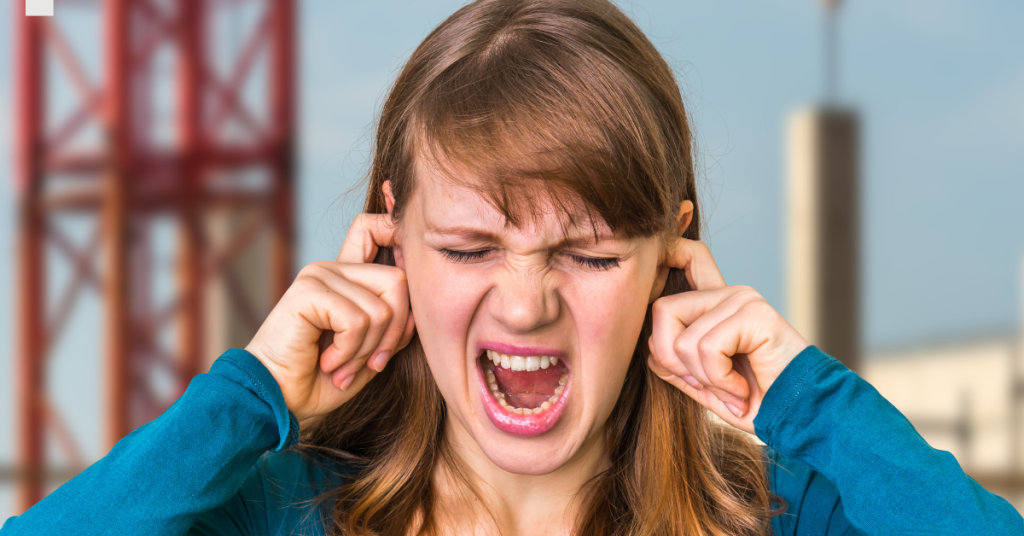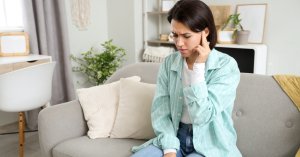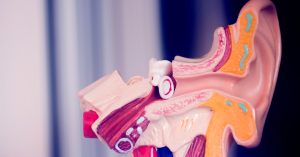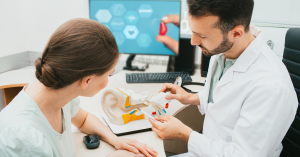In our increasingly noisy world, protecting our hearing is more important than ever. From bustling city streets and noisy workplaces to concerts and personal audio devices, we are constantly exposed to sounds that can pose serious risks to our hearing. One of the most common and preventable forms of hearing damage is noise-induced hearing loss (NIHL) — a condition that affects millions of people, often without their knowledge.
Noise-induced hearing loss occurs when the sensitive structures in the inner ear are damaged by exposure to loud sound. Unlike age-related hearing loss, which typically happens gradually over time due to natural aging, NIHL can happen suddenly or develop slowly depending on the intensity and duration of noise exposure. And while it is most commonly associated with industrial work or military service, NIHL affects people of all ages and occupations — including children, teenagers, musicians, and retirees.
In this article, we’ll take a comprehensive look at what noise-induced hearing loss is, what causes it, how to recognize the symptoms, and — most importantly — how to prevent it. Whether you’ve already noticed some hearing changes or you’re simply looking to protect your ears for the future, understanding NIHL is a vital step in preserving your hearing health for years to come.
What Is Noise-Induced Hearing Loss?
Noise-induced hearing loss (NIHL) happens when the delicate structures inside the ear, particularly the hair cells in the cochlea, are damaged by exposure to loud sounds. These hair cells are essential for translating sound vibrations into electrical signals that the brain interprets as hearing. Once they are damaged or destroyed, they do not regenerate — making the hearing loss permanent in most cases.
NIHL can be temporary or permanent, depending on the intensity and duration of the noise exposure. For example, after attending a loud concert, you might experience a ringing in your ears (known as tinnitus) or feel like sounds are muffled. This is a temporary threshold shift, and hearing usually returns to normal after a few hours or days. However, repeated exposure to loud sounds can cause cumulative damage, leading to permanent hearing loss.
This condition can occur suddenly — such as from a gunshot or explosion — or gradually, through prolonged exposure to noise levels above 85 decibels (dB), which is roughly the volume of heavy traffic or a power lawnmower. The risk increases dramatically as sound levels rise. For context, concerts and sporting events can reach 100–120 dB, and even personal earbuds at full volume can exceed safe listening levels.
It’s important to distinguish NIHL from age-related hearing loss, or presbycusis. While both conditions affect the inner ear, age-related hearing loss is a natural part of aging and typically affects both ears equally over time. NIHL, on the other hand, may affect one ear more than the other, especially if the noise exposure is uneven — such as from firearms or machinery operated on one side of the body.
Noise-induced hearing loss can affect anyone, but it is especially prevalent among workers in noisy environments, military veterans, musicians, and increasingly, younger individuals who frequently use headphones at high volumes. The good news? NIHL is almost entirely preventable. Understanding how and why it happens is the first step toward protecting your hearing for life.
Common Causes of Noise-Induced Hearing Loss
Noise-induced hearing loss doesn’t just happen in factories or battlefields — it can stem from a wide variety of everyday activities and environments. Understanding the common causes of NIHL can help you make informed choices to protect your ears in daily life.
Occupational Noise Exposure
One of the most significant contributors to NIHL is prolonged exposure to loud noise in the workplace. Industries such as construction, manufacturing, mining, aviation, and agriculture often involve machinery and tools that generate dangerously high decibel levels. For instance, a jackhammer or chainsaw can produce sounds exceeding 100 dB. Without proper ear protection, workers in these fields are at constant risk for permanent hearing damage.
Recreational Activities
Many leisure activities also expose people to harmful sound levels. Attending concerts, nightclubs, sporting events, or car races can subject your ears to volumes that exceed safe thresholds. Even short-term exposure at such events can cause immediate and irreversible hearing loss, especially if repeated frequently without protection.
Personal habits like listening to music through earbuds or headphones are also major contributors — particularly among teens and young adults. Listening at maximum volume, especially over extended periods, can be just as damaging as industrial noise exposure. Experts recommend keeping volume below 60% and taking listening breaks to protect hearing.
Firearms and Explosions
Firearms are among the most extreme sources of loud noise, often producing bursts of over 140 dB — well above the safe exposure limit. Hunters, military personnel, and shooting range users face high risks for sudden and severe NIHL. Using high-quality earplugs or earmuffs designed for shooting sports is critical in these settings.
Environmental and Household Noise
Everyday sources of sound can also contribute to hearing damage over time. Leaf blowers, lawnmowers, blenders, and vacuum cleaners can all emit noise in the 80–100 dB range. While these levels may not cause immediate damage, frequent and prolonged exposure without hearing protection adds up. Living near an airport or busy highway can also result in chronic low-level exposure that harms hearing over time.
Music and Entertainment Professions
Musicians, DJs, sound engineers, and event staff face a unique set of risks due to frequent exposure to amplified sound. While music may be enjoyable, it’s still capable of causing hearing damage. In-ear monitors, protective filters, and sound limiters can help reduce the risk while preserving sound quality.
Recognizing the Symptoms of NIHL
One of the most challenging aspects of noise-induced hearing loss is that it often develops gradually and painlessly, making it easy to overlook in its early stages. Many people don’t realize they have a hearing problem until it starts to interfere with their daily life. Recognizing the symptoms early can lead to quicker intervention and better management of the condition.
Difficulty Understanding Speech
One of the first signs of NIHL is difficulty understanding speech, especially in noisy environments like restaurants, family gatherings, or crowded rooms. People with NIHL often report that they can hear people speaking, but they can’t understand what’s being said — a phenomenon known as “speech discrimination difficulty.” This happens because high-frequency sounds, which include many consonants like “s,” “f,” and “th,” are often the first to be affected by noise damage.
Tinnitus (Ringing in the Ears)
Tinnitus, a persistent ringing, buzzing, or humming in the ears, is another common symptom of NIHL. It may be temporary — such as after a loud concert — or it may become chronic with repeated exposure to loud sounds. Tinnitus can be mild and occasional or constant and distressing, significantly affecting concentration, sleep, and quality of life.
Muffled or Distorted Hearing
Sounds may begin to seem muffled or less sharp, even if the overall volume seems unchanged. Music may lose its richness, and conversations may require more focus and effort to follow. People with NIHL might frequently ask others to repeat themselves or increase the volume on the TV or phone.
Increased Sensitivity to Sound
Some individuals develop hyperacusis, a condition where normal sounds become uncomfortably loud or even painful. This heightened sensitivity can be emotionally distressing and may cause people to avoid social or noisy situations altogether.
Social Withdrawal and Fatigue
Because hearing loss makes communication more difficult, many people with NIHL experience frustration, embarrassment, or fatigue from trying to follow conversations. Over time, this can lead to social withdrawal, reduced participation in group activities, and even symptoms of depression or anxiety.
It’s worth noting that noise-induced hearing loss can affect one or both ears. In some cases — such as with firearm use or operating loud tools — the ear closest to the source of the sound may be more severely affected. This asymmetry can be a clue that noise exposure, rather than aging alone, is the cause.
Diagnosing and Measuring Hearing Loss
If you suspect that you or someone you know may be experiencing noise-induced hearing loss (NIHL), the most important next step is a professional hearing evaluation. Diagnosing NIHL accurately not only helps confirm the cause of the symptoms but also guides appropriate treatment and management strategies.
Hearing Tests and Audiograms
The gold standard for diagnosing hearing loss is a hearing test administered by an audiologist or hearing care professional. This usually takes place in a soundproof booth, where you’ll wear headphones and respond to a series of tones at various pitches and volumes. The results are plotted on an audiogram, a visual graph that shows the softest sounds you can hear at different frequencies.
An audiogram helps identify:
- The degree of hearing loss (mild, moderate, severe, or profound)
- The configuration of the loss (which frequencies are affected)
- Whether the loss is sensorineural (damage to the inner ear or auditory nerve), conductive (issues in the outer or middle ear), or a mixed type
NIHL typically presents as a sensorineural hearing loss that begins in the high frequencies — often around 3,000 to 6,000 Hz. This pattern reflects damage to the hair cells responsible for processing higher-pitched sounds.
Speech Recognition Tests
Another critical part of diagnosis is speech audiometry, which evaluates how well you can understand spoken words at different volumes. This test mimics real-life communication and helps determine how hearing loss affects your ability to comprehend speech, particularly in noisy settings.
Medical Examination
In some cases, a physical examination of the ears may be performed to rule out other causes of hearing loss, such as earwax buildup, fluid in the ear, or damage to the eardrum. A referral to an ear, nose, and throat (ENT) specialist may be recommended for further investigation if needed.
When to Get Tested
It’s a good idea to get a hearing test if:
- You frequently ask people to repeat themselves
- You have trouble understanding speech in noisy places
- You experience ringing in your ears (tinnitus)
- You suspect your job or hobbies expose you to loud noise
- You’re over 50 and haven’t had a hearing check in several years
Early diagnosis of NIHL is crucial. While the hearing loss itself may not be reversible, timely detection allows for interventions like hearing aids, communication strategies, and changes in noise exposure that can greatly improve day-to-day functioning and long-term ear health.
Prevention: Protecting Your Ears from Loud Noise
Noise-induced hearing loss (NIHL) is one of the few types of hearing loss that is entirely preventable. Whether you’re in a loud work environment, enjoy high-volume music, or are exposed to environmental noise regularly, taking proactive steps can make a lasting difference. Prevention starts with awareness — and the right habits.
Know the Safe Sound Limits
Sound is measured in decibels (dB). Prolonged exposure to noise at or above 85 dB can cause hearing damage. For reference:
- Normal conversation: ~60 dB
- Heavy city traffic: ~85 dB
- Lawn mower: ~90 dB
- Rock concert or nightclub: 100–120 dB
- Gunshot or fireworks: 140+ dB
The higher the decibel level, the less time it takes to damage your hearing. For example, at 100 dB, hearing damage can occur in as little as 15 minutes. That’s why understanding volume levels — and how long you’re exposed to them — is so important.
Use Hearing Protection
One of the most effective ways to prevent NIHL is to use hearing protection in loud environments. There are several options:
- Foam earplugs: Inexpensive and widely available. Good for occasional use.
- Custom earplugs: Molded to your ears for better comfort and protection. Ideal for musicians, motorcyclists, or frequent users.
- Earmuffs: Cover the entire ear and are often used in industrial or construction settings.
- High-fidelity earplugs: Lower volume without distorting sound — great for concerts and musicians.
Wear hearing protection consistently whenever you anticipate noise levels exceeding safe limits — whether that’s mowing the lawn, using power tools, or attending a music event.
Practice Safe Listening Habits
With the rise of earbuds and headphones, many cases of NIHL now stem from personal audio use. Here’s how to listen safely:
- Follow the 60/60 rule: Listen at no more than 60% volume for no more than 60 minutes at a time.
- Use noise-canceling headphones to block background noise, so you’re not tempted to turn up the volume.
- Avoid using earbuds in noisy environments like subways or busy streets.
Create a Quieter Environment
Reducing unnecessary noise in your daily life also helps preserve your hearing. Consider:
- Choosing quieter appliances when purchasing new equipment
- Soundproofing your home or office space if you live near a loud area
- Taking “quiet breaks” during the day to give your ears time to rest
Be a Role Model for Others
Parents and caregivers play a key role in teaching children about safe hearing habits. Encourage kids to use headphones responsibly and wear ear protection during noisy activities. Similarly, older adults can set an example by wearing hearing protection and discussing the importance of hearing health with friends and family.
Treatment Options and Coping Strategies
While noise-induced hearing loss (NIHL) is usually permanent, that doesn’t mean you’re out of options. Modern hearing care offers a wide range of treatments and strategies to help people manage their symptoms, improve communication, and maintain quality of life. The key is early intervention and a tailored approach that suits your specific hearing needs.
Hearing Aids
For many individuals with NIHL, hearing aids are the most effective treatment option. These small electronic devices amplify sounds to make hearing easier. Today’s hearing aids are far more advanced than previous generations — offering features like:
- Directional microphones to enhance speech in noisy environments
- Bluetooth connectivity for phones and TVs
- Custom programming to match your unique hearing profile
Hearing aids do not restore normal hearing, but they can significantly improve your ability to communicate and engage with others, especially in challenging listening environments.
Assistive Listening Devices (ALDs)
In addition to hearing aids, assistive listening devices can provide extra support in specific situations. These include:
- Personal amplifiers
- TV listening systems
- Telephone amplifiers
- FM systems used in classrooms or meetings
These tools are especially helpful in places where background noise or distance makes hearing more difficult.
Tinnitus Management
If tinnitus (ringing in the ears) is a symptom of your NIHL, there are several ways to manage it:
- Sound therapy using white noise or nature sounds to mask the ringing
- Tinnitus retraining therapy (TRT) to reduce emotional response
- Cognitive-behavioral therapy (CBT) to help cope with the stress or anxiety tinnitus can cause
Some modern hearing aids also come with built-in tinnitus maskers.
Communication Strategies
Incorporating communication strategies into daily life can help ease frustration and improve interactions:
- Face the person you’re speaking to so you can read facial expressions and lip movements
- Ask people to speak clearly (not louder) and repeat or rephrase if needed
- Reduce background noise during conversations — turn off the TV or move to a quieter area
- Inform friends and family about your hearing needs so they can be supportive
Support Networks and Counseling
Living with hearing loss can be emotionally challenging. Connecting with others through support groups or hearing loss organizations can provide valuable encouragement, shared experiences, and practical tips. Some people also benefit from counseling to address the social and emotional impact of hearing loss.
Hearing Conservation for the Future
Even after experiencing NIHL, it’s crucial to protect any remaining hearing. Continue using hearing protection in loud environments and be mindful of your listening habits. Preventing further damage can help preserve your current level of hearing.
Conclusion
Noise-induced hearing loss (NIHL) is more common than many people realize — and it’s one of the few types of hearing loss that is largely preventable. From construction sites and concert halls to personal headphones and lawn equipment, sources of harmful noise are all around us. But the good news is that with awareness, education, and proactive choices, we can protect our hearing and reduce the risk of permanent damage.
Understanding what causes NIHL, how it presents, and how it can be diagnosed empowers you to take control of your hearing health. If you notice signs like difficulty understanding speech, ringing in the ears, or increasing sensitivity to sound, don’t wait — seek a professional evaluation. Early detection can lead to better outcomes and help preserve your hearing ability for years to come.
For those already living with NIHL, today’s hearing technology and communication tools offer powerful ways to stay connected and engaged. Whether through hearing aids, assistive devices, or support networks, there are many resources available to help manage the condition effectively.
Most importantly, remember that hearing is a sense worth protecting. Taking small steps today — like wearing earplugs at concerts, lowering headphone volume, and encouraging others to do the same — can make a big difference in the long run. Your ears are with you for life; treat them with care.
FAQ
What is the most common cause of noise-induced hearing loss?
The most common cause is prolonged exposure to loud sounds over 85 decibels, such as machinery, music at high volumes, and environmental noise like traffic or construction. Occupational and recreational noise exposure are both leading contributors.
Can noise-induced hearing loss be reversed?
Unfortunately, once the delicate hair cells in the inner ear are damaged by noise, they do not regenerate. This makes noise-induced hearing loss permanent in most cases. However, early intervention with hearing aids and lifestyle changes can significantly improve communication and quality of life.
How can I tell if noise is too loud?
If you have to raise your voice to be heard, the noise level is likely above 85 dB and potentially harmful. Ringing in your ears or muffled hearing after exposure is another warning sign. Using a decibel meter app on your smartphone can help measure sound levels in real time.
Do earbuds and headphones cause hearing loss?
Yes, listening to music or audio at high volumes through earbuds or headphones — especially for long periods — is a major cause of NIHL, particularly among younger people. To protect your ears, follow the 60/60 rule: no more than 60% volume for 60 minutes at a time.
Are children and teens at risk for NIHL?
Absolutely. Increasing use of personal listening devices, noisy toys, and exposure to loud environments makes children and teens especially vulnerable. Educating young people on safe listening habits and encouraging the use of hearing protection is vital for long-term hearing health.






